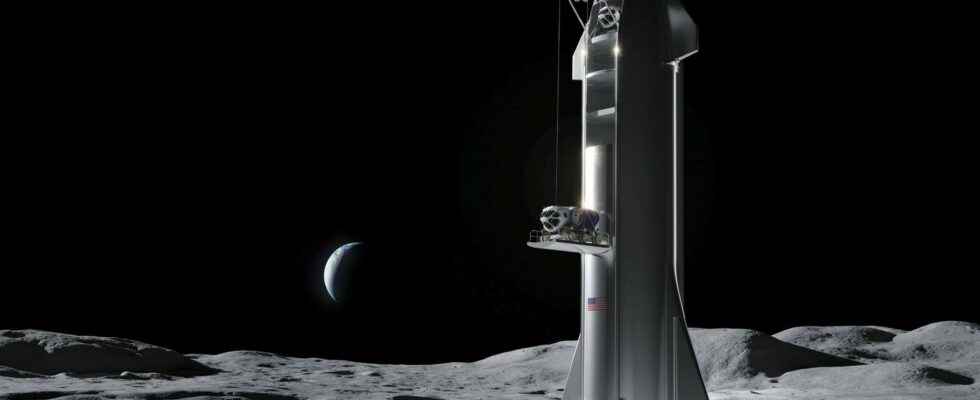Like a modern-day Percival Lowell, Elon Musk is a true Mars enthusiast. So much so that, from the beginning of the 2000s, the young multimillionaire of barely 30 years old wanted to get into aerospace. Initially, Musk’s goal was to build a scientific base on the Red Planet with the project March Oasis. But the costs of such a design forced him to turn to spaceflight, and May 6, 2002 the company is officially created SpaceX. If the new firm is struggling to take off, it will experience a meteoric rise during the 2010s, during which SpaceX engineers will succeed in developing reusable launchers, the Falcons. Musk, news whooping cough of the space conquest, then becomes globally recognized. But if SpaceX aims far, being mandated by the Nasa to design the lunar lander of the Artemis programthe hegemony of the company was challenged by backlashes as well as by the arrival of other private companies such as Blue Origin in the aerospace market.
The greatness of “small” beginnings
When Musk launched SpaceX in 2002, the entrepreneur had “only” $200 million in his pocket, following the sale of two of his companies, PayPal and Zip2. At first, the future billionaire visits Russia to obtain structures of missile Soviet Intercontinental Ballistics (Intercontinental ballistic missile, ICBM), without any real success. Between 2005 and 2008, SpaceX devoted itself to developing Falcon 1 rocket. This first model will fly three times: once in 2006 and twice in 2008, each launch resulting in failure. Despite this, NASA saves the young company from bankruptcy, injecting nearly 300 million dollars into the program Commercial Orbital Transportation Service (the acronym COTS meaning in French, “commercial orbital transport service”). Thanks to this funding, Space X bounced back and began, in 2009, the development of the famous Falcon 9.
This new rocket was launched for the first time in 2010, again with the support of NASA. The American agency provides strong support to SpaceX and establishes several contracts with the firm. SpaceX scientists are then working on a new way to reuse launchers. Developed by Wernher von Braun at the end of the 1940s, this idea had already been exploited in the past. In 1993, aircraft manufacturer McDonnell Douglas designed the Delta Clipper reusable launcher which will be abandoned by NASA in 1997. Avant-garde, the Delta Clipper proposed a landing powered by rocket engines, almost 20 years before the Falcon 9. At the same time, the European Space Agency was considering, for the rocket Ariadne 5the question of the reusable, problematic, and which will be evoked again fifteen years later concerning Ariadne 6. In 2015, after several successful launches but failed landings, SpaceX managed to save a Falcon 9 in its entirety. A technical feat noticed internationally.
The Odyssey to Mars
Satellite launches follow one another for SpaceX, in partnership with public and private agencies. In 2018, the super-heavy launcher is tested Falcon Heavydesigned to be able to transport orbit low payload of almost 64 tonnes. In 2019, voices are raised to denounce the starlink projectintended to place several thousand satellites in low orbit to provide coverage Internet world. The astronomers amateurs and professionals point light pollution generated by the constellation of satellites. At the same time, SpaceX continues to be mandated by NASA. In 2020, one capsule Crew Dragon placed on top of a Falcon 9 leads two astronauts Americans (Doug Hurley and Bob Behnken) towards international space station. From then on, SpaceX will carry out several manned missions to the ISS. In 2021, the French Thomas Pesquet and German Matthias Maurer both flew a Crew Dragon to reach the station.
As the U.S. Space Administration continues to plan for the return of astronauts to the Moondesign and construction of the lunar lander, named Human Landing System, were entrusted by NASA to SpaceX. The architecture of the HLS is based on the Starship, super-heavy vessel capable of carrying (theoretically) a hundred tons in low orbit. If Elon Musk’s company has carried out several tests of the Starship, these proved to be inconclusive. The various flights of Starships NS made in 2021 ended in fireworks. We will still have to wait to place astronauts on top of Elon Musk’s new XXL toy.
The entrepreneur did not hide his intention: to put men on the Moon by 2025 and disembark the first Martian settlers on the Red Planet before 2030. It is difficult to predict whether the billionaire’s ambitions will be achievable in the time available. SpaceX President Gwynne Shotwell announced on May 6, 2022 that the Starship will perform its first orbital flight between June and July 2022, after clearance from Federal Aviation Administration (FAA, Federal Aviation Administration). This milestone could then mark a big step forward for SpaceX, the Artemis program and the conquest of space.
Interested in what you just read?
